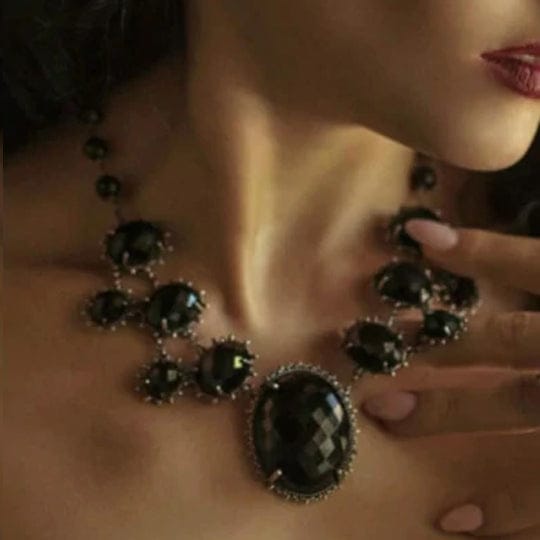Combining Medieval and 18th Century Elements
The term "Gothic" is associated with the Germanic tribes that rose to prominence in Europe after the fall of the Roman Empire. They were the builders of great cathedrals such as Notre Dame de Paris, the Milan cathedral, and Glastonbury Abbey. Unlike the various forms that contemporary Gothic jewelry currently takes, the jewelry associated with the "Gothic" period uses primarily yellow gold and precious stones. Though the jewelry didn't originally take the architectural design elements present in the cathedrals, the jewelry’s forms and techniques were just as intricate and detailed. The basse-taille enameling technique gave way to email en ronde bosse, allowing precise and colorful enamels to expand into three-dimensional work. The prevalent cuts for stones by the 14th century were point cut and table cut. Women wore such intricate jewelry to express their power and influence amidst the prevailing norms of conformity and masculinity.
Michelle Valadon Designs exhibits tremendous care and attention in every piece we create. Like the pieces of jewelry popular in the medieval age, each piece embodies a woman's yearning to be identified for her uniqueness and is her way of extending her grace and power as only a woman can. Inspired by the immortal, the Gothic Diamonds Black Diamond Ring is an eternity band of alternating diamond shape motifs and black diamond florals. Its textured silver patina reminds us of medieval treasures. The mesmerizing quality of black diamonds is set in a petal-shaped, floral miligrain beadwork. The diamonds in brilliant-cut evolving from the table cut prevaleint from the 15th century onwards. The black diamond itself symbolizes strength, power, and majesty.
The Victorian Era
The greater part of the 19th Century is identified by the reign of Queen Victoria of England. Her fashion sensibilities greatly influenced the jewelry of the age. Her deep love and longing for her deceased husband, the late Prince Consort Albert, is connected to the dark and somber colors that began to gain popularity in 1861, the start of her decades of mourning. The graceful lines and the choice of stones were also an expression of women's newfound freedom. These design elements, choice of metals, and stones are what we associate with Gothic jewelry today. The fascination with the macabre and the afterlife and alternate perceptions of the divine feminine, the night, and the sacred essence and majesty imbued in every woman led to design trends that adopted medieval architectural elements and stone choice. Jewelry design elements such as textured silver patina and precious and semi-precious stones like black onyx and black diamonds reflect the era's spirit.
Inspired by the Victoria era, "The Majestic" faceted Onyx necklace is a faithful rendition of the age's sensibilities and spirit. The faceted onyx stone signifying strength and the many unique facets of a woman embodies the woman who yearns to break free from the shackles of societal expectations and express her power, her sacred essence, and her own majestic qualities.The Late 20th Century
The late 20th century saw the rise of the gothic (goth) subculture as we know it. Its modern origins began in the 1970s in the United Kingdom with proponents of “gothic rock,” whose musical rhythms and themes border on the dark and sinister. Themes of gloom, darkness, and blood, which were also en vogue with the revival of interest in vampire-themed movies and literature, attracted followers to the gothic subculture. Just like the aesthetic qualities of the fashion of the time, Gothic jewelry's dark and highly symbolic characteristics match its proponents' sensibilities, propelling Gothic jewelry to the forefront of goth culture. Modern Gothic jewelry adapts to these darker themes with the addition of stainless steel, silver, or white gold as metals of choice instead of yellow gold. Unlike yellow gold, which symbolizes the sun, these new metals symbolize its counterpart, the moon. Stones are usually either black or white as the subculture shuns gaudy colors. Because of their association with blood, rubies are another common element in goth jewelry.
One element that characterizes most contemporary Gothic jewelry is its vivid symbolism, as ingrained in the Strength in Virtue Ring. Religious elements borrowed from Christian or Pagan religions represent the jewelry accents of the time. Though ruby symbolizes nobility, purity, and vitality, it also symbolizes blood in the gothic subculture. The white diamonds and the ethereal sheen of white gold in prominently repeating bands of sharp patterns reminiscent of Old World designs found in the Diamonds of Eternity Diamond Ring is a perfect example of this expression.
Today
Though gothic subculture continues to exist as a counter-culture, Gothic jewelry has found a more mainstream acceptance. Today, Gothic jewelry is a statement of liberation and expression that embodies the essence of each woman as the source of life, love, and emotion. It serves to counteract the social conventions that perpetuate a male-dominated world. Gothic jewelry presents the opportunity for every woman to provide a strong statement of her independence. By providing a strong contrast of dark and light elements to represent negative and positive energies pervading around us, what stands out as much as the jewelry is the strong woman who wears it.
One example of this assertion is the Petals of Divina. These earrings, inspired by Gothic architectural elements, resemble a cathedral window as if allowing a peek into the wearer’s soul. The floral patterns are highlighted by deeply symbolic faceted onyx, a statement of the wearer’s femininity and exceptionality that stands out as a shining beacon of strength, balance, confidence, and grounded harmony.









